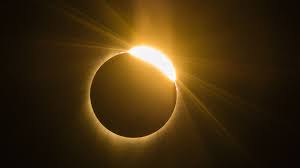When a rare complete solar eclipse sweeps across North America on Monday, scientists will be able to collect crucial data on everything from the Sun’s atmosphere to unusual animal behaviours, as well as potential human repercussions.
It comes as the Sun approaches the apex of its 11-year solar cycle, preparing for a dazzling display: the corona will light spectacularly from the Moon’s silhouette along the path of totality, which runs from Mexico to Canada via the United States.
Total solar eclipses provide “incredible scientific opportunities,” NASA Deputy Administrator Pam Melroy stated at a press briefing this week.
The United States Space Agency is one of the institutions preparing for the eclipse, with plans to launch “sounding rockets” to research the impact on the Earth’s upper atmosphere.
Here’s what researchers hope to learn from the approaching eclipse.
When the Moon passes directly in front of the Sun, the outermost edge of the Sun’s atmosphere, or corona, is seen “in a very special way,” according to Melroy.
“Things are happening with the corona that we don’t fully understand,” she went on to say.
The heat within the corona increases as one moves away from the Sun’s surface, a counterintuitive phenomenon that scientists are still trying to understand and explain.
Solar flares, which are quick explosions of energy that emit radiation into space, and solar prominences, massive plasma formations that loop out from the Sun’s surface, both occur in the corona.
During an eclipse, the bottommost part of the corona — where much of this activity occurs — is more clearly visible than when specialised instruments are used to block the central part of the Sun, providing an excellent opportunity for study, according to Shannon Schmoll, director of Michigan State University’s Abrams Planetarium.
Researchers are particularly excited because the Sun is nearing the pinnacle of its 11-year cycle.
“The chance we’re going to see something amazing is very high,” Melroy said in a statement.
The total eclipse will allow scientists to analyse changes in the ionosphere, which impacts radio waves for communication and navigation.
“Disturbances in this layer can cause issues with GPS and communications,” said Kelly Korreck, NASA headquarters’ eclipse programme manager.
The Sun affects the ionosphere, which is where Earth’s atmosphere meets space, by electrically charging the particles there during the day.
NASA’s three sounding rockets will be launched from Virginia prior to, during, and immediately following the eclipse to assess these changes.
The eclipse’s significant fall in sunlight, which was more quick and localised than a typical sunset, may allow researchers to learn more about how light impacts the ionosphere and better predict potential disruptive events.
During eclipses, animals may exhibit unusual behaviour, such as giraffes running and roosters crowing and chirping.
Aside from the reduction in sunshine, temperatures and wind — elements to which animals are sensitive — can also fall dramatically during an eclipse.
Andrew Farnsworth, an ornithology researcher at Cornell University in New York, investigates how eclipses influence birds by employing weather monitoring radar to detect birds in flight.
During the previous total solar eclipse viewable from the United States in August 2017, scientists noticed a “decline in the number of animals flying around,” Farnsworth told reporters.
The 2017 eclipse disrupted the everyday activity of insects and birds, but it did not cause typical animal nocturnal behaviours such as bird migration or bat emergence, according to the expert.
Given that the eclipse is in April, he believes birds will be more likely to migrate during this time.
“These kinds of patterns — they’re important for understanding the ways animals perceive their worlds,” Farnsworth went on to say.
Human wonder –
“Eclipses possess a unique power. “They inspire people to feel reverence for the beauty of our universe,” NASA Administrator Bill Nelson told reporters.
In 2017, researchers researched this sense of wonder using data from roughly three million Twitter users (now known as X).
According to Paul Piff, a psychology professor at the University of California, Irvine, those in the so-called “path of totality,” in which the Moon completely blocks out the Sun, used the pronoun “we” (rather than “I”) and expressed care about other people.
“What we’re finding is that experiences that bring about awe… seem to attune people and connect us to one another, to connect us to entities that are larger than ourselves,” Piff went on to say.
This year, he intends to investigate the impact of the event on societal political divisions.
Approximately 40 citizen scientific initiatives are planned for the eclipse, ranging from registering temperature and cloud cover via phone app to monitoring ambient sounds.
“We encourage you to help NASA observe the sights and sounds around you,” he stated.



